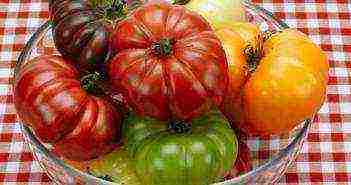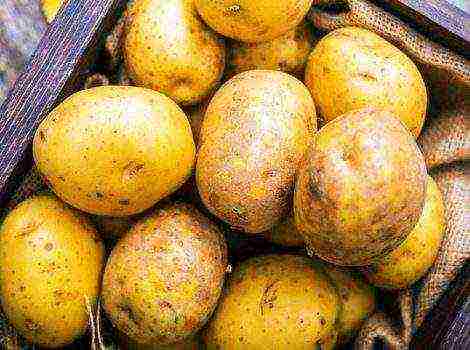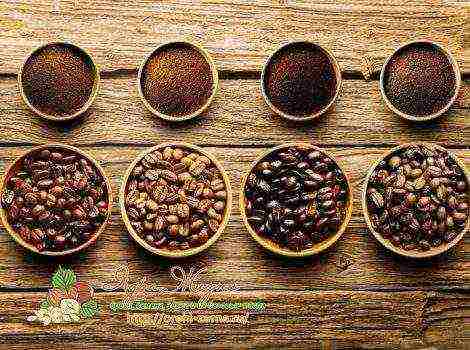Content
- 1 Kohlrabi cabbage varieties. Photo with title and description
- 2 Description of kohlrabi cabbage
- 3 Popular varieties
- 4 Landing
- 5 Kohlrabi care tips
- 6 Diseases and pests dangerous for culture, methods of control and prevention
- 7 Reviews
- 8 Early varieties of kohlrabi
- 9 Late varieties of kohlrabi cabbage
- 10 Goliath white
Many summer residents are engaged in the cultivation of a vegetable such as kohlrabi cabbage. The varieties differ in shape, color, and ripening times. Fans of this root vegetable note its unusual shape, and the capacity of many useful substances in it puts it on a par with healing medicines aimed at maintaining strength and restoring health.
Outwardly, the vegetable looks like a small spherical fruit, on which several leaves of different sizes are formed (depending on the variety). Basically, it is the round fruit that is eaten. It has a fairly compact, medium density, structure and delicate taste. The leaves can often be used fresh for making salads.
The name of this interesting type of cabbage comes from the German word “kohlrabi”, which means “turnip cabbage”. Why did this vegetable crop get this name? Some people compare it to a turnip, only in cabbage the leaves grow independently, and in turnips they are collected in one bunch and grow from the base of the root vegetable together. Of course, the similarity is quite high, so you can call it that way.
Regardless of the variety of kohlrabi cabbage (see photo), each young and juicy fruit is very rich in vitamins A, B, C, D, E, K, as well as enzymes (pantothenic acid), fiber. It is also positioned as the richest in calcium. It can be safely placed on a par with cottage cheese or milk. Nutritionists recommend consuming kohlrabi every day.
It should be noted that the cooking methods for this cabbage are very diverse. It can be used for salads, stewed, boiled, baked, fried in breadcrumbs, and also pickled. Pickled, it is especially good in combination with some varieties of tomatoes and cucumbers.
To choose a suitable vegetable of this type, it is necessary to determine the best varieties of kohlrabi cabbage for growing at home.
Kohlrabi cabbage varieties. Photo with title and description
It is noteworthy that early varieties of kohlrabi cabbage are most suitable for fresh salads and liquid dishes. Mid-season is used, in most, for stuffing, stewing or baking. But late varieties are best pickled.
The fruits of this vegetable can have not only a different, rounded shape, but also color. As for the shape, there are oval, flat-round, round or egg-shaped fruits. There are two main groups by color:
It should be noted, since late varieties have a very short ripening period (about 80-90 days), this time is quite enough to get a good harvest in cold regions. Therefore, you can choose any early or late variety of kohlrabi cabbage.For the Urals and Siberia, the first generation Sonata and Kossak hybrids are the best.
According to reviews, the best varieties of kohlrabi cabbage have the following names:
Due to the variety of varieties, each summer resident can choose the best option to meet his needs. The vegetable has a beautiful extraordinary appearance, so it can be safely used to decorate garden beds, as well as to create original compositions near flower beds.
Kohlrabi is a very unusual variety of cabbage, which, despite its long history, is just beginning to win the favor of domestic gardeners.
This crop is appreciated not only for its delicate taste and high content of nutrients, but also for its fast ripening, excellent yield and ease of growing. Kohlrabi varieties there are quite a few, so every summer resident can choose an option that is suitable for specific climatic conditions.
Early varieties
Early varieties of kohlrabi ripen in 55-70 days and are resistant to cold snaps and high yields. Such hybrids are characterized by a delicate taste and delicate aroma, the pulp of the stems is very juicy, it is easy to cut and quickly cooked. Early kohlrabi cabbage is suitable for fresh consumption and is often not suitable for long-term storage, since, as a rule, it has a low keeping quality.
The most popular among gardeners are the following varieties:
back to contents ↑ Moravia
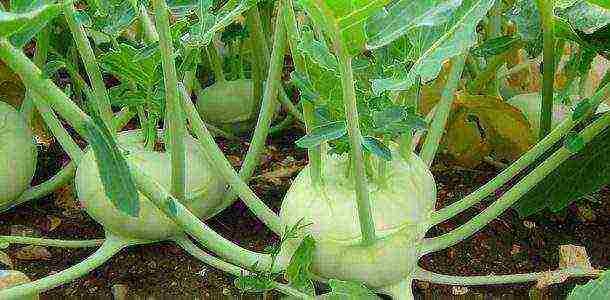
Differs in very good cold resistance and resistance to shooting, cracking and wooding. Forms a stem plant with a diameter of 10 cm, weighing up to 2.2 kg with a light green skin and white juicy pulp. Not suitable for long-term storage.
back to contents ↑ Atena

A hybrid of Czech breeding, which gives a consistently rich harvest and is grown throughout the country. Stem fruits are round in shape, weighing up to 220 g with light green skin and juicy white pulp.
Back to contents ↑ Sonata F1

A variety suitable for growing immediately in the open field, it can give up to 2-3 harvests per season. Stem fruits reach a mass of 600-700 g, have a purple rind and a delicate core.
Back to contents ↑ Vienna White 1350

The most common variety of kohlrabi, characterized by excellent cold resistance and amicable ripening of stems. The weight of cabbage can vary from 300 g to 1 kg, the "heads" are distinguished by light green skin and juicy tasty pulp.
to content ↑ Mid-season varieties
Mid-season varieties of kohlrabi cabbage ripen in 80-120 days and usually yield a good harvest. Plants tolerate small cold snaps well and take root on different types of soil, and stems are resistant to cracking and woodiness. The best mid-season hybrids are:
back to contents ↑ Karatago F1

A variety of Czech selection, it is distinguished by good yield and good maturity of the stems. The weight of cabbage usually reaches 300 g, the stems have a light green skin and a delicate core. This hybrid is resistant to cracking and wooding and is therefore suitable for storage.
back to contents ↑ Blue Planet F1

Cold snap-resistant variety that grows well outdoors. Forms small bluish-green stems weighing up to 250 g with tender, but dense pulp. The hybrid is suitable for long-term storage.
back to contents ↑ Violetta
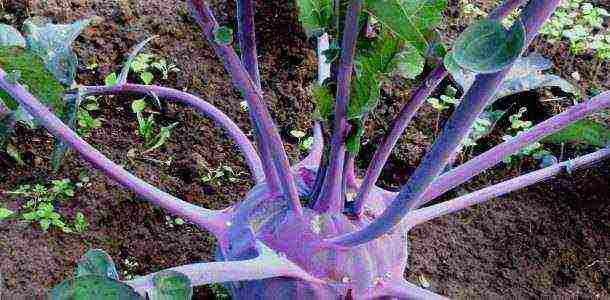
A very popular variety that is resistant to frost, cracking and wooding. It differs in dark purple stems with a diameter of 7-10 cm and a weight of 1.5-2 kg. Cabbage has excellent taste and is suitable for fresh consumption and for processing and storage.
Back to contents ↑ Azur

A variety for fall and spring cultivation. Differs in high resistance to shooting and tolerates well even severe drought. Forms spherical stems with purple peel and white sweet flesh.During storage, cabbage does not crack and does not lose its taste.
back to content ↑ Late-ripening varieties
The growing season of late kohlrabi varieties is 120-180 days. They are distinguished by high resistance to frost and shooting, while having excellent keeping quality. Late cabbage is best suited for conservation and long-term storage, since it has a denser pulp than early varieties. Among the most popular hybrids, it is worth highlighting:
back to contents ↑ Giant
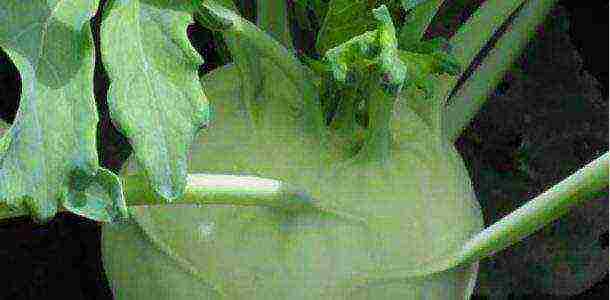
Czech variety that is grown throughout Russia. Differs in high drought resistance and resistance to shooting. Forms large stems, the weight of which can reach 1.5-2 kg, with tender and juicy pulp. This hybrid is suitable for long-term storage and canning.
back to contents ↑ Cossack F1
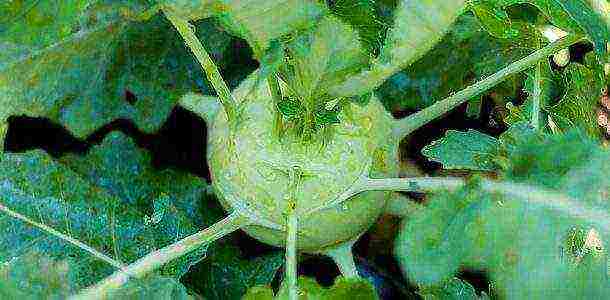
A variety with high frost resistance and suitable for growing in regions with cold climates. Stem fruits grow up to 600 g in weight, they have a light yellow rind and juicy flesh with a mild taste.
back to contents ↑ Globe

Also a popular variety of kohlrabi, which is resistant to woody stem plants and tolerates cold snaps well. It gives large stems weighing 3-5 kg, which can be consumed fresh, and preserved or stored in winter.
back to content ↑ How to choose a suitable variety for growing
When choosing a kohlrabi variety, it is important to be guided by the goals of cultivation and the climatic features of a particular region. So, wanting to enjoy fresh cabbage salads as soon as possible, you should give preference to early hybrids. When planning to prepare kohlrabi for the winter or prepare canning from it, it is better to choose mid-season and late varieties.
It is also worth considering the size of the stems that form certain types of cabbage. For example, too large "heads" can be inconvenient for fresh consumption or for creating blanks for the winter. You can learn more about the types of kohlrabi and their names in the photo on the Internet.
back to contents ↑ Video tip
If you find an error, please select a piece of text and press Ctrl + Enter.
Kohlrabi is one of the most unusual varieties of cabbage. It has a very delicate pulp taste and a record content of vitamins, macro- and microelements. Culture is not devoid of other advantages - it is early maturity, and productivity, and relative ease of care. In the gardens of Russian gardeners, kohlrabi is not yet found too often, but it is quickly gaining popularity.
Description of kohlrabi cabbage
Kohlrabi is one of the many varieties of cabbage, the genus is part of the Cruciferous family. Its close relatives are radish, radish and rutabaga. Like any cabbage, it is a plant with a two-year development cycle. During the first season, a thick stalk is formed in it, the next summer the culture forms a peduncle and gives seeds in pod fruits. But most gardeners do not wait for this moment, eating the stem crop.
The birthplace of kohlrabi is Sicily. It was domesticated for a very long time, during the heyday of the Roman Empire. Then this vegetable was almost the main part of the diet of the poor and slaves. The modern name is of German origin and means "stem turnip".
Kohlrabi prefers a temperate climate, does not like extreme heat. Therefore, it is suitable for growing in most of the territory of Russia. At the same time, its root system is much more developed than that of other varieties of cabbage, kohlrabi suffers less from drought, does not require frequent watering. The stemfruit is formed in just 8-10 weeks, so you can harvest two crops a year if you plant it with seedlings for the first time.

It is impossible to confuse kohlrabi with other varieties of cabbage.
Kohlrabi has few leaves, they are rather narrow, with long petioles. The shape of the sheet plate is elliptical or triangular with rounded corners.
The diameter of the stem grows up to 12-18 cm. But many gardeners prefer to harvest when it grows to 6-10 cm. In this case, the pulp is much softer, juicier and more tender. The fruit is in the shape of an almost regular ball, egg or turnip. Its average weight is 200-300 g, but there are also varieties for which heads of cabbage weighing more than 2 kg are the norm.
The stem fruit is painted in salad, purple or ink-violet color (depending on the variety). The pulp is greenish-white. By its taste, it is almost impossible to distinguish it from the common cabbage stump. But kohlrabi is much juicier and sweeter, without a slight aftertaste of bitterness.
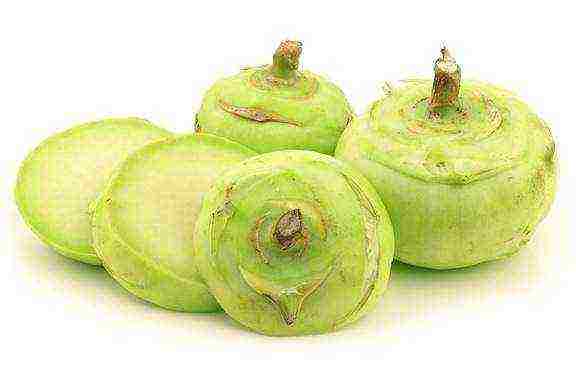
The flesh of kohlrabi is greenish-white, very juicy, without bitterness
Kohlrabi is deservedly called "northern lemon" or "vitamin bomb". In terms of vitamin C content, it is much superior to other varieties of cabbage and citrus fruits. You can also note the presence of vitamins A, B, D, E, F, P, PP, potassium, calcium (about the same as in cottage cheese and milk), phosphorus, iron, zinc, iodine, selenium, cobalt, organic acids, fiber and fructose.
The content of nutrients in kohlrabi leaves is greater than in the stem crop itself.
This cabbage is recommended to be eaten fresh. Kohlrabi goes well with any fresh vegetables and is well suited for making salads. It is also stewed, fried, boiled, baked, but during heat treatment it loses a significant part of its nutrients. Fruits are low in calories (only 48 kcal per 100 g), so they may well diversify any diet and baby food. At the same time, kohlrabi does not provoke excessive gas formation, like other types of cabbage. It is also suitable for home canning. Most often it is pickled, sometimes an assortment is prepared with tomatoes and cucumbers.
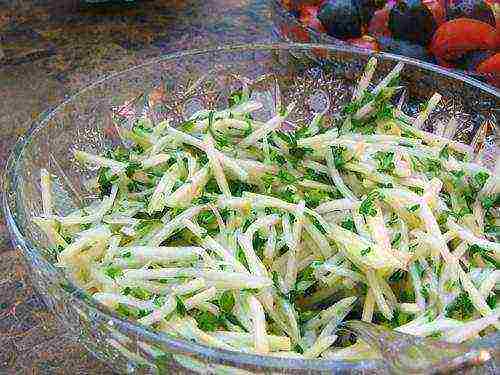
Fresh kohlrabi salad - a storehouse of vitamins and minerals
Nutritionists recommend drinking as much pure water or any unsweetened drinks as much as possible when eating kohlrabi regularly. Do not overdo it with juice (the recommended daily dose is no more than 1 tbsp.).
The stemfruit very easily accumulates nitrates in itself, which can provoke the development of some serious diseases. Therefore, it is advisable to eat only self-grown kohlrabi.
Popular varieties
Many varieties and hybrids of kohlrabi have been bred, differing in size, shape and color of the stem. When choosing, it should be borne in mind that the most tender and juicy pulp is in the early white-fruited varieties. Those with a purple color are better suited for canning and long-term storage, they are distinguished by a larger size of stems.
Early varieties
Early kohlrabi ripens in 55–70 days, medium ripening varieties - in 85–120 days, late varieties - in 120–150 days.
Early ripe varieties of kohlrabi are intended mainly for fresh consumption. They do not differ in keeping quality. The following varieties are most popular with gardeners:
- Piquant. One of the ultra-early ripening varieties. It can be planted both in the spring and closer to the middle of summer. The pulp is dense, but at the same time juicy, it does not coarse and does not crack, it is well stored. The stems are small, light green, almost round. Average weight - 0.6-0.8 kg;
- Gusto. The variety is early, but the stem is colored deep purple. Its average weight is 0.4–0.75 kg, its shape is slightly flattened. Practically not stored, suitable only for fresh consumption;
- Vienna White-1350. One of the most popular early varieties among Russian gardeners. The stem crop is large, weighing 2–2.5 kg. The taste is almost standard - the pulp is juicy, tender and sweetish. When planting at different times, depending on the climate, you can take 2-4 crops per season. Productivity is consistently high, fruiting is amicable. The Venskaya blue variety is practically no different from this variety of kohlrabi, with the exception of the violet with a bluish tint of the color of the stem-grower and higher frost resistance;
- Delicacy red.Another exception is an early variety with a purple-violet head of cabbage. The shape of the stalk is almost a regular ball, its weight is about 1.6–2.2 kg. As its size increases, the dense pulp does not lose its juiciness, softness, taste does not suffer either. Differs in good frost resistance;
- Moravia. The variety is recognized as one of the best for cultivation in the climate of central Russia. It stands out for its frost resistance even against the background of other varieties of kohlrabi. Plants almost never shoot, heads of cabbage do not crack, the pulp retains its juiciness and softness. A stem crop with a diameter of 12-14 cm and weighing more than 2 kg. Not stored for long;
- Athena. Kohlrabi is from the Czech Republic. Differs in a consistently high yield, suitable for growing almost throughout Russia. The stems are spherical, medium-sized, weighing up to 0.25 kg. The pulp is very juicy;
- Sonata F1. It can give 2-3 harvests per season even when cultivated in the open field. The average weight of the stem is 0.5–0.8 kg, the pulp is juicy and soft. The head of cabbage is colored inky purple;
- Corist F1. A very common hybrid, appreciated by gardeners mainly for its taste. The stemfruit is round or slightly flattened, lettuce-colored. Diameter - up to 10 cm, average weight - 0.5–0.7 kg. Heads of cabbage do not crack, coarse fibers do not form in them. It is used mainly fresh, the shelf life is no more than a week.
Photo gallery: early varieties and hybrids of kohlrabi
Medium ripening varieties
Most of the kohlrabi varieties of medium ripening are heat- and drought-resistant, their heads almost never crack. The most common varieties and hybrids:
- Blue Planet F1. A salad-colored stem fruit with a bluish tint, small (weighing no more than 0.25 kg). The shape is slightly flattened. The pulp is tender, but firm enough. Due to this, the crop is well stored;
- Karatago F1. Czech hybrid, bears fruit abundantly, regardless of weather conditions, the crop ripens en masse. The average weight of the crop is 0.3–0.4 kg. Heads of cabbage do not crack and do not "stiffen". The variety is suitable for long-term storage;
- Delicacy white. Stem fruit weighing about 0.5 kg, slightly flattened. The taste is excellent. The flesh is very juicy, does not "stiffen";
- Violetta. The variety is very common in Russia. The stemfruit has a deep purple color, from a distance it seems almost black, with a thick gray-blue bloom. Average weight - about 2 kg, diameter - 10-12 cm. The shape resembles a turnip. The taste is excellent. The purpose is universal. Shelf life - up to 1.5–2 months;
- Madonna. The stems are flattened, lilac in color with a greenish-blue tint. Purpose - universal, excellent taste. Average weight - 1–1.5 kg;
- Purple Haze. In shape, the stems resemble turnips. Average weight is 1.5–2 kg. The variety is distinguished by good keeping quality, drought and heat resistance;
- Gulliver. The stems are almost round, weighing up to 1.5 kg, pale green, sometimes with a yellowish undertone. Leaves are drooping. The leaf plate is grayish green. The variety is recommended to be consumed fresh.
Photo gallery: kohlrabi, medium ripening
Late varieties
Late kohlrabi is prized for its firmness and resistance to shooting. It is also characterized by frost resistance and the large size of the stems. Under optimal conditions, this kohlrabi is stored for up to six months.
- Giant. The variety is late, but the stem is greenish in color. It is quite large, weighing 1.6–2 kg. The head of cabbage is almost round, the flesh is very juicy. The variety does not suffer from extreme heat, prolonged drought. Bred by Czech breeders specifically for long-term storage and home canning;
- Azur. Differs in very high drought resistance, plants do not shoot. The stem fruit is purple, spherical. The pulp is snow-white, with a distinct sweetish aftertaste.This kohlrabi is stored for six months or more, in the process its taste and quality do not suffer, the heads of cabbage do not crack;
- Kossak F1. Differs in extremely high frost resistance, suitable even for growing in northern regions. The stems are medium in size, weighing 0.6–0.8 kg. They are colored green with a yellowish undertone. The pulp is very juicy, sweetish;
- The globe. It tolerates sudden changes in temperature, while the pulp does not "stiffen" and does not lose its juiciness. The stems are round, very large, weighing 3-5 kg. The appointment is universal;
- Alka. The stem is inky purple, rounded or slightly elongated. It is appreciated for its excellent taste and versatility. It is stored without loss of quality at least until the end of winter, well suited for freezing.
Photo gallery: late varieties of kohlrabi
Landing
Kohlrabi is relatively unpretentious. It successfully takes root and bears fruit even on poor soils. But, of course, obtaining a bountiful harvest and the largest possible size of stems is impossible under such conditions. The ideal option is a light but nutritious substrate such as loam.
It is imperative to find out the acidity of the soil in advance. The sour substrate of kohlrabi, like any cabbage, categorically does not tolerate. Keela develops almost inevitably in such soil. The situation can be corrected by adding slaked lime, dolomite flour, powdered eggshells (200-400 g / m²) during the preparation of the beds. Humus or rotted compost (10-15 liters per 1 m of the garden) will help to increase the fertility of the soil.
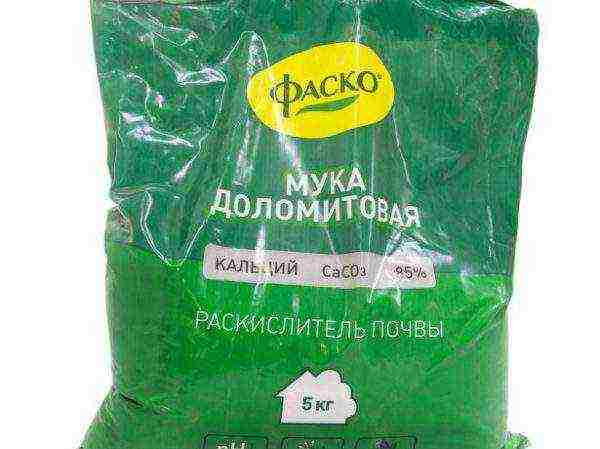
Dolomite flour is a natural soil deoxidizer that does not have any side effects
Kohlrabi is frost-resistant. Even the seedlings just transplanted into the garden, which did not manage to get away from the "stress", endure a short cooling down to -2 ° C, adult plants are not damaged if the temperature drops to -8 ° C. But kohlrabi does not like heat and direct sunlight. This must be taken into account when choosing a place for the garden.
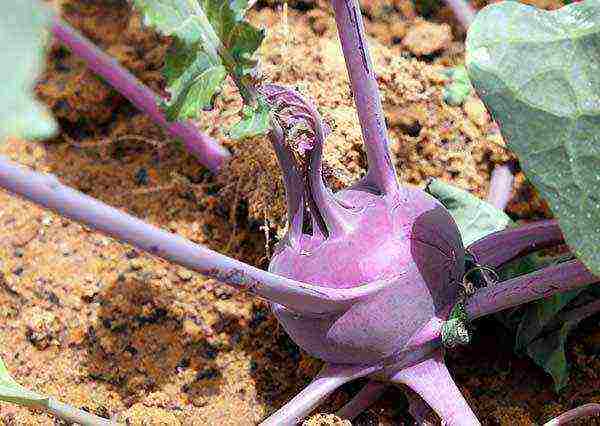
Kohlrabi does not tolerate intense heat too well, it negatively affects the quality of the fruit
Landing dates
Early kohlrabi varieties are most often grown in seedlings to bring harvest time closer. Later, since the frost resistance of the culture allows, they are planted immediately with seeds in open ground, covered with plastic wrap or other covering material.
Seeds of early kohlrabi varieties are planted for seedlings at the end of winter or at the very beginning of March. The harvest ripens by the end of May. After about 2-3 weeks, the same varieties are sown on seedlings again, for the second "wave" of fruiting, which occurs at the end of summer. To get a harvest during the summer, early and mid-season kohlrabi are planted both on seedlings and seeds in open ground in April. The optimal time for late varieties is the last decade of May or early summer.
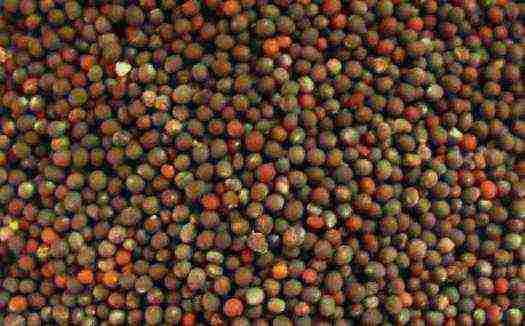
Kohlrabi seeds can be planted both on seedlings and directly into open ground
Seedling preparation procedure
- The seeds are immersed in hot (45-50 ° C) water for 15–20 minutes, then immediately into ice, literally for a minute or two. Then they are soaked for 10-12 hours in a solution of any biostimulant (Epin, Zircon, potassium humate). Folk remedies are also suitable - succinic acid, aloe juice.
- After the specified time, the seeds are washed and wrapped in a damp cloth or napkin. Then they are placed in the warmest place in the apartment. For example, you can put them in a saucer and put them on a radiator. The fabric must be constantly sprayed from a spray bottle, not allowing it to dry out.
- After 2-3 days, the seeds should hatch. When this happens, they are seated one at a time in small plastic cups or peat pots. This allows you to do without picking, which kohlrabi does not like very much - a significant number of seedlings die after the procedure.
- Soil: universal soil for seedlings or a mixture of peat, humus and fertile turf in approximately equal proportions.
- The seeds are buried by a maximum of 1–2 cm.
- The pots are covered with plastic bags to create a greenhouse effect and transferred to a dark, warm place. The optimum temperature is 20–22 ° C. As soon as the shoots appear, they are provided with light and the temperature is sharply lowered to 8 ° C. After 8–10 days, it is raised again to 17–20 ° C during the day and 11–13 ° C at night. If it is warmer, the plants will stretch ugly.
- To prevent the development of "black leg", kohlrabi seedlings are watered only with water at room temperature, alternating with a pale pink solution of potassium permanganate. When the plants form two true leaves, they are fed with a solution of any complex fertilizer for seedlings (Sprout, Ideal).
- They begin to prepare seedlings for planting in about 2 weeks, hardening them. The time spent outdoors is gradually extended from 1–2 hours to 10–12 hours. A week before planting, kohlrabi stop watering.
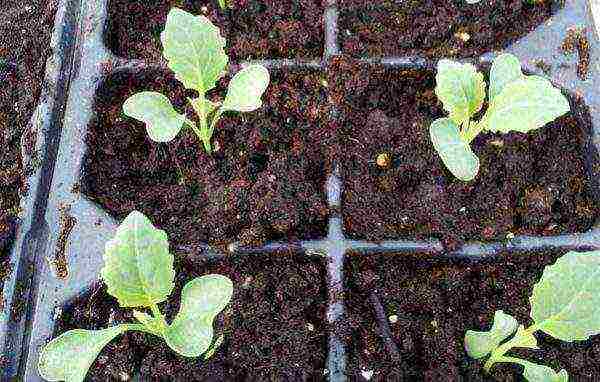
Kohlrabi seedlings appear quickly and amicably
Planting seedlings in the ground
Kohlrabi seedlings are ready for planting in the ground a month after the shoots appear. It should have 3-5 true leaves standing upright. It is not recommended to hesitate with disembarkation. The stem fruit will either not form at all, or it will turn out to be deformed, and the pulp will be tough, not juicy, fibrous.
Early kohlrabi seedlings are planted as soon as the soil warms up to 8–10 ° C. If you delay, the plants can go into the “arrow”. The late one is transferred to open ground in the second decade of July to harvest in September or in the first half of October.
Kohlrabi compares favorably with other types of cabbage in that each plant needs a very small area for nutrition. Between them leave about 20-25 cm, between the rows - about 30 cm. On 1 m², thus, "get along" 8-10 plants.
Step by step process:
- Before planting seedlings, each hole 6-10 cm deep is well watered and fertilized - 8-10 g of simple superphosphate and a handful of sifted wood ash.
- All this is mixed, the bushes are planted in the resulting "mud" at the bottom of the hole. When landing in the ground, kohlrabi is not buried more deeply than before. The root collar should be at about the same level, because the stem crop is formed just above it. Ideal if the seedlings are grown in peat pots. Then the plants do not need to be removed from the container at all.
- Then the soil is carefully compacted, watered and mulched again. Peat and sawdust are not suitable for this, especially conifers - they strongly acidify the soil.
- The best time for the procedure is the evening of a cloudy cool day. Then for 7-10 days above the plants, it is advisable to build a canopy of any white covering material to protect them from direct sunlight.
Neighbors for kohlrabi
Growing kohlrabi in greenhouses and hotbeds is undesirable, especially together with other crops that require frequent feeding, including mineral fertilizers. Kohlrabi, on the other hand, accumulates nitrates in the stem very quickly.
When choosing a place for kohlrabi, you need to take into account what has grown on this bed earlier. Bad predecessors are other plants from the Cruciferous family. But it is quite possible to plant it after cucumbers, tomatoes, potatoes, beets, carrots, onions, garlic, any spicy herbs and legumes.
Sowing seeds in the ground
Kohlrabi seeds are planted directly into the ground in grooves 2-3 cm deep with an interval of about 30 cm between them. The furrows are sprinkled with a thin layer of humus, the bed is tightened with any covering material. Seedlings are thinned out when the first true leaf is formed, carefully cutting off weaker plants with scissors. If you pull them out, you can damage the roots of neighboring seedlings.
Video: how to plant kohlrabi seeds for seedlings
Kohlrabi care tips
Kohlrabi is undemanding to care. This is due, among other things, to the short vegetative period.
Watering
During the first 15–20 days after planting, kohlrabi is watered every 2-3 days. Further, it does not need especially frequent watering. As a rule, it has enough natural precipitation. If it is extremely hot outside, the garden is watered once a week. The water must be warmed up, the best time for the procedure is evening.

Only kohlrabi seedlings recently transplanted into the ground need regular watering
An exception is the moment when the stem grower begins to form (the plant should have 6–8 leaves). From this time on, the soil must be constantly kept in a slightly moist state so that the heads of cabbage do not crack. Mulch will help save time on watering. She will not let the weeds overgrow the garden bed.
After watering, the bed is loosened deep (6–8 cm), but only the aisles. The plants themselves do not spud. If you cover the stem with earth, it will stretch out.
It is very important to water the kohlrabi regularly. Abrupt transitions from completely dry soil to a bed turned into a swamp is one of the main causes of cracking of stems.
Top dressing
Early kohlrabi is fed twice. A week after planting in the ground, the leaves are sprayed with a solution of carbamide and potassium sulfate (10–12 g per 10 l of water). Approximately 2 weeks before harvest - watered with infusion of fresh cow dung, bird droppings, nettle or dandelion leaves. Late varieties are fed with such infusions every 15–20 days.
Harvesting and storage
Kohlrabi meant for food can be removed whenever you like. If the stalks are planned to be stored for a long time, choose a warm, dry day. They are dug up together with the roots, dried for several hours in a place with good ventilation, protected from direct sunlight. Then the ground is cleaned off, the leaves are cut off. The stems together with the roots are folded into boxes, sprinkled with sand, sawdust, scraps of paper so that they do not come into contact with each other. Optimal storage conditions are temperature 0–2 ° C, humidity 90–95%, a dark room with good ventilation. Kohlrabi will stay in the refrigerator for a maximum of 2 weeks.
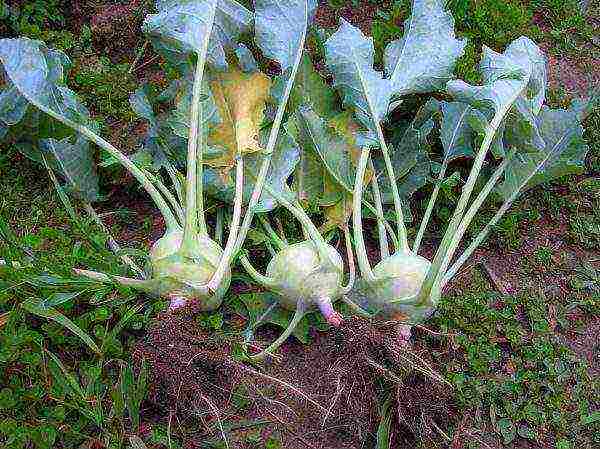
The collected kohlrabi is stored along with the roots.
Video: recommendations for growing kohlrabi
Diseases and pests dangerous for culture, methods of control and prevention
Kohlrabi suffers from the same diseases and pests as other varieties of cabbage. There are a lot of them, so you need to be able to identify them and know the appropriate control and prevention measures.
Of the pests for kohlrabi, they are dangerous:
- cabbage aphid. Pale green insects stick around the leaves and stem in a solid mass. The stem crop turns out to be small and deformed, the damaged tissues change color to beige-yellow with a pinkish border. Pungent-smelling herbs or infusions of them growing next to kohlrabi effectively scare off aphids. You can also use onion, garlic, orange peel, tobacco chips as raw materials. The same measure will help get rid of the pest if you increase the frequency of treatments from 1 time per week to 3-4 times a day. In the event of a mass invasion of aphids, Inta-Vir, Fury, Iskra-Bio, Mospilan are used;
- cruciferous flea. Small black beetles with a shimmering blue-green shell feed on plant juices. Vague yellowish spots form on the leaves and stem, the plant withers. Effective prevention - marigolds, calendula, tansy surrounding the kohlrabi garden. Cotton swabs moistened with kerosene or turpentine are laid out in the aisles. To combat the pest, Aktar, Fosbecid, Aktellik are used;
- cruciferous bug. Black-yellow beetles make round holes in the leaves, the larvae eat out the stemfruit from the inside, gnaw at the roots. Control measures are the same as with the cruciferous flea;
- cabbage moth. It eats tissue from the inside, as a result the leaves and stems become covered with "tunnels". Regular weed control is essential. Plants are planted next to the kohlrabi bed, emitting natural phytoncides - coriander, tomatoes, onions, garlic. Folk remedies for fighting moths - infusion of hot pepper, tobacco crumbs.Of the chemicals, Decis, Arrivo, Lightning are most often used;
- cabbage whites. Lime-colored caterpillars devour the leaves, gradually moving from the edges to the middle. They can be collected by hand, but this is ineffective. Folk remedies are also not particularly effective. Traps can be used against adults - sheets of cardboard greased with jam or containers filled with sugar syrup or honey diluted with water. To cope with caterpillars, use Kinmiks, Fitoverm;
- cabbage scoop. Late ripening kohlrabi especially suffers from it. Caterpillars eat up the stalks from the inside, contaminate the pulp with excrement. A folk remedy for the prevention of the appearance of a pest is an infusion of wormwood, burdock leaves or tomato tops. Of the chemicals used are Bankol, Sherpa, Iskra-M;
- cabbage fly. The larvae eat away the roots and stems from the inside. The plant abruptly stops in development, withers and dies. To prevent the appearance of cabbage flies, the soil in the garden is dusted with a mixture of tobacco dust with naphthalene, ash or camphor. To combat it, any general action insecticides are used.
Photo gallery: what pests dangerous for kohlrabi look like
Common kohlrabi diseases:
- "blackleg". It can destroy future crops already at the seedling stage. The root collar becomes thinner, changes color to black-brown, rots. For prophylaxis, seeds are etched in a solution of Alirin-B, Agata-25K for 15–20 minutes before planting. At the first signs of the disease, the affected plants are removed from the garden, the soil is sprayed with a 1% solution of Bordeaux liquid, copper sulfate;
- keel. It develops almost inevitably if the acid-base balance of the soil is below 6.0. Ugly growths of various shapes are formed on the roots. The plant cannot eat normally, the aerial part sharply inhibits development, stems are not formed. For prevention, the seeds must be kept in hot water before planting. Fighting the keel is almost impossible. The gardener can only remove the affected plants from the garden and disinfect the soil with a bright pink solution of potassium permanganate;
- downy mildew (peronosporiosis). Vague yellowish spots appear on the outside of the leaves, and a grayish or whitish coating on the inside. They quickly turn black, die off. Cold weather and high humidity contribute to the development of the disease. For prophylaxis, kohlrabi is powdered with sifted wood ash, crushed chalk, and colloidal sulfur every 10–12 days. To combat the disease, Ridomil-Gold, Strobi, Fitoftorin are used;
- alternaria. Small black spots on the leaves gradually increase in size, turning into concentric circles. Then they become covered with a grayish blotch with black blotches. For prophylaxis, 5-7 days after planting, kohlrabi is sprayed with Trichodermin. In case of the appearance of characteristic symptoms, any fungicides are used - Poliram, Abiga-Peak, Bravo, Acrobat-MC;
- bacteriosis (black rot). On the leaves (mainly in the area of veins), small “translucent” brownish spots of a round shape appear. Then the fabrics soften, become slimy to the touch, and spread an unpleasant putrid odor. For prophylaxis, Glyocladin granules are introduced into the soil during planting. Preplant heat treatment is also important. You can fight the fungus with any copper-containing preparations;
- fusarium. Vague yellow spots appear on the leaves between the veins. Gradually, they completely turn yellow and dry. On the cut, brown blotches are visible in the tissues. For prophylaxis, plants are watered with a pale pink solution of potassium permanganate every 2-3 weeks. To defeat the fungus, use Topsin-M, Horus, Benomil.
Photo gallery: symptoms of diseases typical for kohlrabi
Reviews
There are no particular difficulties in growing kohlrabi. At the same time, you can significantly save space - the culture requires a much smaller area than ordinary white cabbage.Gourmets appreciate it for its very delicate and mild taste, adherents of a healthy lifestyle - for the record content of substances useful for the body and low calorie content. Breeders have bred many varieties, each gardener can choose the one that best suits him. Kohlrabi is suitable for cultivation in most of Russia.
27 years old, higher legal education, broad outlook and interest in a variety of topics. Rate the article:
(0 votes, average: 0 out of 5)
Kohlrabi is a vegetable that is completely different from cabbage, more similar to rutabaga or turnip. In the first year of life, forms a tender and juicy rounded stem. In this article, we will describe the best kohlrabi varieties domestic and foreign selection.
Early varieties of kohlrabi
Vienna White 1350
This is an early ripening variety of kohlrabi. The growing season lasts from germination to the onset of economic suitability 65-75 days. This variety of kohlrabi cabbage is suitable for growing both in the open field and in greenhouses (greenhouses and greenhouses). The rosette of leaves is small (30-45 centimeters in diameter). The leaves of the variety Viennese white 1350 are lyre-shaped, light grayish-green, smooth. Petioles are thin (up to 0.6 cm), long, leaf blades are triangular, small (length 16-27 cm, width 9-24 cm). The outer stump is very short. The stem fruit is light green, round or flat-round in shape, the average diameter at the stage of economic validity is about 7 - 9 centimeters, the marketable and taste qualities of cabbage are good. The flesh of the stalk is whitish, green, tender, juicy. Keeping quality is poor. The stem crop is prone to very rapid growth. The variety is quite heat-resistant and drought-resistant, strongly affected by cabbage keel.
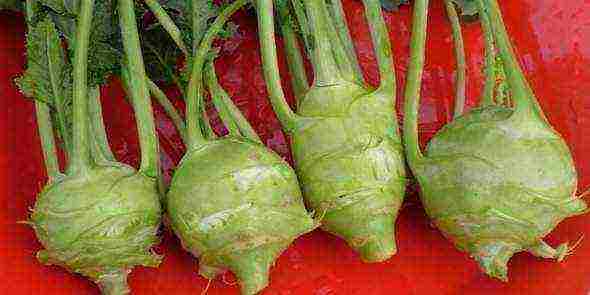
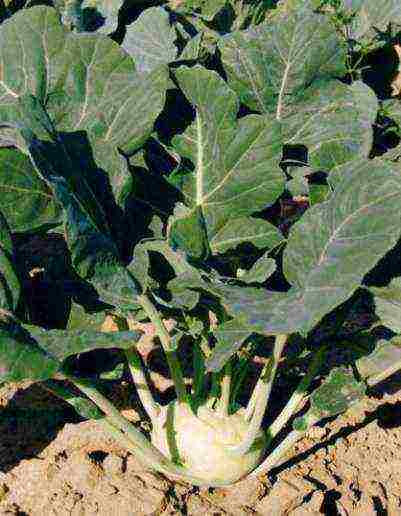
Photo of kohlrabi "Vienna White"
| On a note. The taste of the kohlrabi turnip stalk is similar to the cabbage stalk, but sweeter and juicy. This dietary product contains a lot of potassium, sulfur, glucose and fructose salts, vitamins and ascorbic acid (surpassing lemon and orange in the latter!). The stem weight ranges from 200 grams to 5 kg in the best kohlrabi varieties. |
Vienna blue
An early ripening variety of kohlrabi, ripens a few days later than the Viennese white variety. The rosette of leaves is shallow. The leaves are similar in size and shape to the Venskaya Belaya variety, but have a violet color with leaf veins and petioles. The stalk of cabbage variety Vienna blue in shape and size is the same as that of Vienna white, the color of the peel is purple. The pulp is white, tender, juicy. This variety is more resistant to overgrowth in comparison with the Venskaya Belaya variety.

Photo variety of kohlrabi cabbage "Vienna blue"
Optimus Blue Povir
The variety is early ripening, ripens six days later than the Viennese white. 68-90 days pass from germination to the beginning of economic validity. The rosette of leaves is small and medium in size. The leaves are similar to the leaves of Viennese white, but the petioles and plates are larger. The stem crop of the Optimus blue variety Povir of the variety is flat-round or round, purple in color. Ripening of stems is amicable. It is more resistant to flowering, grows more slowly, and is more stable in comparison with the Venskaya Belaya variety. The average yield of kohlrabi cabbage is 23 kg from ten m². Distributed in the regions of the Far North.
Prague white early distillation
Early variety of kohlrabi cabbage. The rosette of leaves is small, raised. Leaves are small, light green in color, petiole of medium length or long, thin. The stem fruit is flat-rounded or round, light green in color. The pulp is white, of high taste, juicy. Keeping quality is poor. The variety is prone to overgrowth. It is used for forcing both in greenhouses and greenhouses, and is also grown outdoors.
Moravia
A very early variety of kohlrabi cabbage. The rosette of leaves is small, raised. Leaves are small, dark green, petiole of medium length or long, thin.The stemfruit is flat-round, light green in color. The flesh of the Moravia variety is of high taste, white, juicy, tender. Keeping quality is poor. The variety is prone to overgrowth. More resistant to cold weather than Prague White.

On the photo kohlrabi variety "Moravia"
Field stupitska early
Early variety. The rosette of leaves is not large. Leaves are broadly oval, dark green. The petiole is of medium length. The stemfruit is flat-round, light green. The early variety kohlrabi naveitska field is suitable for cultivation in the field.
Erfordia
Very early variety. Small rosette of leaves. Leaves are smooth, broadly oval, running down to the base, green in color. Petioles are of medium length, thin. The stem fruit is small or medium, flat or flat-round, light green. Used for forcing in greenhouses and growing in the field.
Konan
A variety that has recently appeared on the market, and has already confidently taken a place among the best kohlrabi varieties of foreign selection. Early ripe - ripens in 42 days. The skin is smooth, the flesh is snow-white, sweet, crunchy. The diameter reaches 16 cm. It is resistant to diseases.
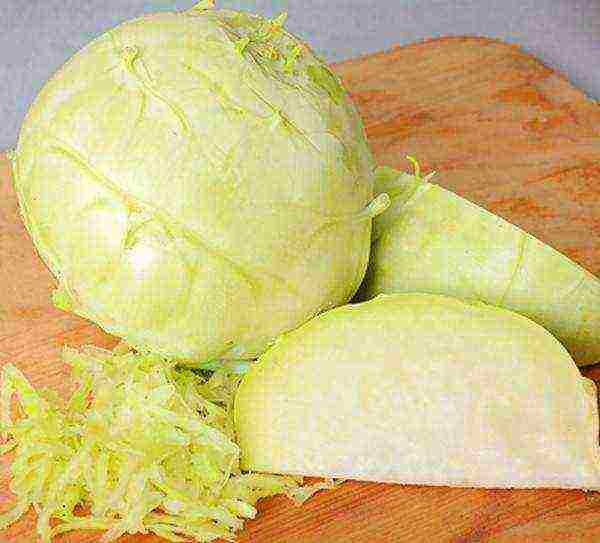
Photo "cabbage-turnip" variety Konan
Early Knauf
A very early variety. The rosette of leaves is shallow. Leaves are smooth, oval, green in color. The petiole is of medium length, thin. Early Knauf kohlrabi cabbage stalk of medium size, flat-round or flat in shape, light green. Early variety Knauf is used for indoor and outdoor use.
Late varieties of kohlrabi cabbage
Violetta
Violetta is an excellent late-ripening variety of kohlrabi cabbage. Stem (stem plant) weighing up to two kg, with excellent taste and juicy pulp, dark purple (white inside). The Violetta variety is resistant to dry weather, low temperatures, and is suitable for storage.
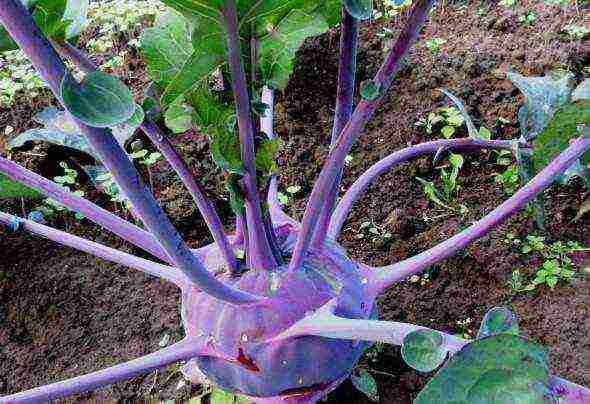
Photo of kohlrabi cabbage variety "Violetta"
Goliath white
Late-ripening variety. Ripens three weeks later than Vienna White. The rosette of leaves is large (60-70 cm in diameter). The leaves are large, green. Petioles are thick (more than 1 cm), long. The leaf blades are large (more than 25-30 cm long), triangular, gray-green. The stemfruit of kohlrabi cabbage of the Goliath variety is white, round or flat-round, large (over 20-25 cm in diameter), light green in color.
The palatability is lower than that of Vienna White. The pulp is white, juicy, dense. Keeping quality is good. The variety is drought-resistant, yielding 300-500 centners per hectare. The variety is resistant to overgrowth.
Goliath blue
Late-ripening variety, similar to white goliath. The stem fruit is flat-rounded and rounded, purple in color. The variety is resistant to overgrowth and cracking, high-yielding, keeping. Used as food at a young age.
Giant
Late variety of kohlrabi cabbage (photo is presented below). Ripe after 3 months. Planting of seedlings of the "Giant" variety into the ground is carried out in May (scheme 50x20 centimeters). The Giant's rosette is semi-vertical, large, with a diameter of about 60 centimeters. A stemfruit with a diameter of 18 cm is large, round, yield 3.5 kilograms per sq. m. The color is whitish-greenish, the pulp is juicy, the taste is good. The kohlrabi variety "Gigant" is characterized by good yield and high keeping quality.
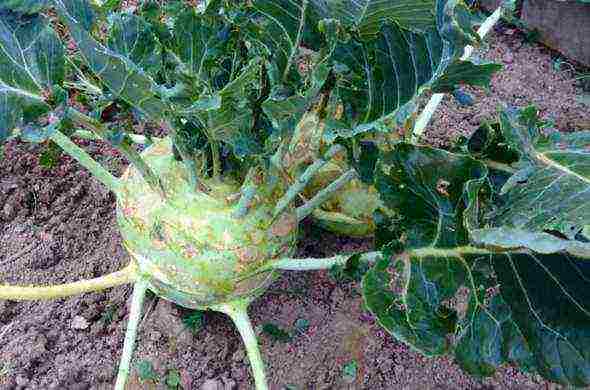
Photo of a head of kohlrabi cabbage variety "Giant"
Delicious white kohlrabi
Foreign grade. Delicacy kohlrabi ripens in 65 days. The skin is soft, light green. When grown in winter greenhouses, when other kohlrabi varieties cracked, this variety continued to grow well and tasted excellent. Can already be eaten when the stem fruit reaches the diameter of a tennis ball. At the same time, the taste of both a small stem and a grown one is always delicate.
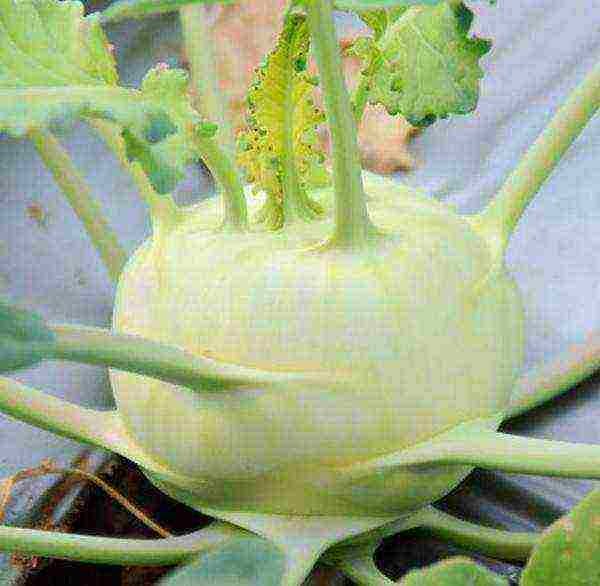
Photo of a gourmet variety
